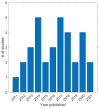A Systematic Review of Sensor Fusion Methods Using Peripheral Bio-Signals for Human Intention Decoding
- PMID: 36080778
- PMCID: PMC9460678
- DOI: 10.3390/s22176319
A Systematic Review of Sensor Fusion Methods Using Peripheral Bio-Signals for Human Intention Decoding
Abstract
Humans learn about the environment by interacting with it. With an increasing use of computer and virtual applications as well as robotic and prosthetic devices, there is a need for intuitive interfaces that allow the user to have an embodied interaction with the devices they are controlling. Muscle-machine interfaces can provide an intuitive solution by decoding human intentions utilizing myoelectric activations. There are several different methods that can be utilized to develop MuMIs, such as electromyography, ultrasonography, mechanomyography, and near-infrared spectroscopy. In this paper, we analyze the advantages and disadvantages of different myography methods by reviewing myography fusion methods. In a systematic review following the PRISMA guidelines, we identify and analyze studies that employ the fusion of different sensors and myography techniques, while also considering interface wearability. We also explore the properties of different fusion techniques in decoding user intentions. The fusion of electromyography, ultrasonography, mechanomyography, and near-infrared spectroscopy as well as other sensing such as inertial measurement units and optical sensing methods has been of continuous interest over the last decade with the main focus decoding the user intention for the upper limb. From the systematic review, it can be concluded that the fusion of two or more myography methods leads to a better performance for the decoding of a user's intention. Furthermore, promising sensor fusion techniques for different applications were also identified based on the existing literature.
Keywords: data fusion; human-intention decoding; muscle–machine interfaces; myography.
Conflict of interest statement
The authors declare no conflict of interest.
Figures
Similar articles
-
Signs and symptoms to determine if a patient presenting in primary care or hospital outpatient settings has COVID-19.Cochrane Database Syst Rev. 2022 May 20;5(5):CD013665. doi: 10.1002/14651858.CD013665.pub3. Cochrane Database Syst Rev. 2022. PMID: 35593186 Free PMC article.
-
Comparison of the effectiveness of inhaler devices in asthma and chronic obstructive airways disease: a systematic review of the literature.Health Technol Assess. 2001;5(26):1-149. doi: 10.3310/hta5260. Health Technol Assess. 2001. PMID: 11701099
-
A rapid and systematic review of the clinical effectiveness and cost-effectiveness of paclitaxel, docetaxel, gemcitabine and vinorelbine in non-small-cell lung cancer.Health Technol Assess. 2001;5(32):1-195. doi: 10.3310/hta5320. Health Technol Assess. 2001. PMID: 12065068
-
Bioengineered nerve conduits and wraps for peripheral nerve repair of the upper limb.Cochrane Database Syst Rev. 2022 Dec 7;12(12):CD012574. doi: 10.1002/14651858.CD012574.pub2. Cochrane Database Syst Rev. 2022. PMID: 36477774 Free PMC article.
-
Cost-effectiveness of using prognostic information to select women with breast cancer for adjuvant systemic therapy.Health Technol Assess. 2006 Sep;10(34):iii-iv, ix-xi, 1-204. doi: 10.3310/hta10340. Health Technol Assess. 2006. PMID: 16959170
Cited by
-
Enabling Remote Responder Bio-Signal Monitoring in a Cooperative Human-Robot Architecture for Search and Rescue.Sensors (Basel). 2022 Dec 21;23(1):49. doi: 10.3390/s23010049. Sensors (Basel). 2022. PMID: 36616647 Free PMC article.
-
Sowing Depth Monitoring System for High-Speed Precision Planters Based on Multi-Sensor Data Fusion.Sensors (Basel). 2024 Sep 30;24(19):6331. doi: 10.3390/s24196331. Sensors (Basel). 2024. PMID: 39409371 Free PMC article.
-
A Multimodal Bracelet to Acquire Muscular Activity and Gyroscopic Data to Study Sensor Fusion for Intent Detection.Sensors (Basel). 2024 Sep 25;24(19):6214. doi: 10.3390/s24196214. Sensors (Basel). 2024. PMID: 39409254 Free PMC article.
References
-
- Dwivedi A. Ph.D. Thesis. The University of Auckland; Auckland, New Zealand: 2021. Analysis, Development, and Evaluation of Muscle Machine Interfaces for the Intuitive Control of Robotic Devices.
-
- Vogel J., Castellini C., van der Smagt P. EMG-based teleoperation and manipulation with the DLR LWR-III; Proceedings of the IEEE/RSJ International Conference on Intelligent Robots and Systems (IROS); San Francisco, CA, USA. 25–30 September 2011; pp. 672–678.
-
- Dwivedi A., Gorjup G., Kwon Y., Liarokapis M. Combining electromyography and fiducial marker based tracking for intuitive telemanipulation with a robot arm hand system; Proceedings of the 2019 28th IEEE International Conference on Robot and Human Interactive Communication (RO-MAN); New Delhi, India. 14–18 October 2019; pp. 1–6.
-
- Shieff D., Turner A., Dwivedi A., Gorjup G., Liarokapis M. An Electromyography Based Shared Control Framework for Intuitive Robotic Telemanipulation; Proceedings of the 2021 20th International Conference on Advanced Robotics (ICAR); Ljubljana, Slovenia. 6–10 December 2021; pp. 806–811.
Publication types
MeSH terms
LinkOut - more resources
Full Text Sources



